Newton and Kepler's Laws

Nature and Nature's Laws lay hid in Night:
God said, 'Let Newton be!' and all was Light.
- Alexander Pope
Kepler's laws of planetary motion are:
1. The orbit of a planet is an ellipse with the Sun at one focus.
2. A line from a planet to the Sun sweeps out equal areas in equal times.
3. The square of the time of revolution of a planet is proportional to the cube of the transverse axis of its elliptical orbit, with the same constant of proportionality for all planets.
Kepler published the first two laws in 1609, the third in 1619, based on the extensive and accurate planetary observations of Tycho Brahe in the late 16th century (no telescopes!). The prolific and imaginative Kepler attempted to link the solar system to musical harmony theory in his early book The Harmony of the World, also to a configuration of the five Platonic solids inscribed in each other (the known planets then consisted of Mercury, Venus, Earth, Mars, Jupiter, and Saturn).
Professor Rob Knop explains lucidly how Tycho, Kepler, and Newton contributed, each in his own way, to building the modern understanding of planetary motion:
Tycho, Kepler, and Newton: observer, phenomenologist, and theorist. Respect them all, for all of their contributions to science are essential. Without any one, the contributions of the other two would have been less, or even impossible.
Keep in mind that this took almost 200 years to unfold, milestones being Copernicus's De revolutionibus in 1543, Tycho's work in the late 1500s, Kepler's in the early 1600s, and Newton's planetary theory starting in the 1660s and culminating in the Philosophiæ Naturalis Principia Mathematica (The Mathematical Principles of Natural Philosophy[1]), first published in 1687 and recognized as central by the third edition in 1726 and English translation in 1729, though the older vortex theory of Descartes continued strong into the 18th century (the link is to the first English translation - see the Wikipedia account as well).
An inverse square law for gravitation was in the air in the mid 1600s, but no one could show it. That is Newton's paramount contribution, to prove that elliptical orbits imply an inverse square law - what Brackenridge calls the "Kepler problem" and an example of a direct problem (that an inverse square law implies elliptical orbits is an indirect problem). Newton made good headway when he came back home from university in 1666, when he was 23 years old and in spare moments when not revolutionizing the theory of colors and light or inventing the calculus. The matter was considered extensively by English luminaries in the 1680s and the astronomer Edmond Halley (he of the comet) visited Newton at Cambridge in August 1684 to discuss the matter. According to Abraham de Moivre:
After they had been sometime together, the Dr [Halley] asked him what he thought the curve would be that would be described by the planets opposing the force of attraction towards the sun to be reciprocal to the square of the distance from it. Sr Isaac replied immediately that it would be an Ellipsis, the Dr struck with joy & amazement asked him how he knew it, Why saith he I have calculated it. Whereupon Dr Halley asked him for his calculations without any further delay. Sir Isaac looked among his papers but could not find it, but he promised him to renew it, & then send it to him.[2]
"Why saith he I have calculated it" - immortal words. In November 1684 Newton sent Halley a short document now titled De motu corporum in gyrum (On the motion of bodies in orbit)[3], just nineteen pages printed out - see the Wikipedia page for a good summary in English. It contained the germ of the Principia, itself forthcoming by April 1687. Rather than the indirect problem Newton claimed to have solved in the quote, De motu contained a proof of the direct problem, immeasurably more important because such broad principles apply to every particle in the universe.
In this article I propose to follow Professor J. Bruce Brackenridge's reconstruction of De motu in his outstanding book The Key to Newton's Dynamics: The Kepler Problem and the Principia[4], kindly placed online at the link by the University of California Press. Professor Brackenridge convincingly asserts that De motu contains the essence of the argument and that it is more accessible than the Principia, which layers and elaborates the argument, making it harder to understand.
The definitive source for the text of De motu is The Mathematical Papers of Isaac Newton, Volume VI (1684-1691), by D. T. Whiteside (ed.)[5], pp 30-91, where Newton's Latin and an English translation appear side by side, accompanied by copious commentary - see here for an excerpt (left-click for popup window). Newton's Latin is largely intelligible even for someone rusty in that language: "Sunto Ellipseos axis transversus AB, axis alter PD, latus rectum L, umbilicus alteruter S" (Let the transverse axis of the ellipse be AB, the other axis PD, the latus rectum L, and S one of the foci). You might even deduce that umbilicus (navel) is Newton's term for focus (!). Whiteside's monumental work is fittingly published by the Cambridge University Press, Newton's old school, and is available at a reasonable price.
Natural philosophers of Newton's time (today called physicists) were steeped in Euclid and the conics, as if they were Greeks studying such matters in 200 BC. The very point of the renaissance was to rescue and recover the revered learning of the ancients. Consider Edmond Halley, for example, Newton's loyal friend and protector who wheedled De motu out of him and encouraged him to expand it into the Principia. Halley made a valiant effort, still extant, to recover Book VIII, the "lost book" of Apollonius's Conics from circa 200 BC (Euclid is said to have had a work on conics 100 years earlier, now lost). It's striking how the ellipse, second only to the circle in the scrutiny received by any curve since Euclid, and largely for aesthetic reasons, took such a central place in astronomy 2,000 years later. Newton was as devoted to that kind of mathematics as any of his peers and as adept at it, even when advancing it in radical directions with his new dynamics and fluxions.
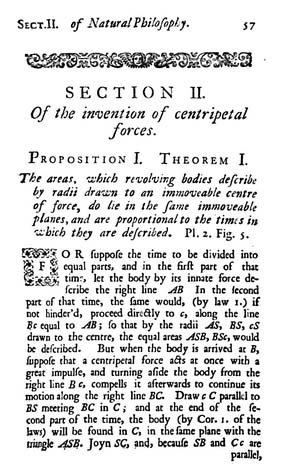
This is Theorem 1 of De motu and Proposition I, Theorem I in the Principia and, stunningly, the proof requires nothing specific about an inverse square law; all that is required is some force law attracting the satellite to a fixed point. Here it is from the Principia:
The areas, which revolving bodies describe by radii drawn to an immoveable centre of force, do lie in the same immoveable planes, and are proportional to the times in which they are described.
Newton assumes that an impulsive force acts on the planet at equally spaced intervals, directed towards the immoveable center of force at S. During the first interval, the planet travels in a straight line from A to B and would continue to move along the straight line to c were it not for the impulsive force acting at point B along the vector \( \vec{BS} \), deflecting the motion towards C. The motion continues unimpeded in a straight line (Newton's First Law!), but now a different one, towards C. And so on, C being the next point at which an impulsive force acts, directed towards S and again deflecting the path from the straight line it had been travelling and on to another one approaching D. The polygon ABCD ... approximates the orbit and all the more closely the shorter the intervals between impulsive forces in this thought experiment.
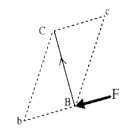
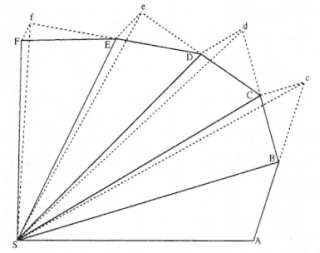
These diagrams are from Brackenridge, the big one based on the Principia. Bc is the course the motion would take were there no impulsive force acting at B. Since the time intervals are equal, AB = Bc, SB is a median of ΔSAc, and ΔASB has the same area as ΔBSc. The action at B is the result of two effects, much like projectile motion on the surface of the earth is a result of a horizontal or slanted displacement as the projectile moves along that direction at constant velocity, combined with the downward displacement caused by the earth's gravitational acceleration. The first, non-accelerating motion is analogous to that experienced by the planet in moving from B to c, as it would unimpeded by any acceleration; the second, accelerated motion is analogous to that imparted by the earth's gravity, but now it is an impulsive force acting at B and directed towards S. The smaller diagram on the left is an extract of the larger one, emphasizing the momentary impulsive force F acting at B, where b is in the direction of S. In modern notation, \( \vec{BC} = \vec{Bb} + \vec{Bc} \) - the individual displacements combine according to the parallelogram law to produce the resultant displacement \( \vec{BC} \). Geometrically, this all implies that \( cC \parallel Bb \) and therefore \( cC \parallel BS \), since Bb is a segment of BS.

Drop a perpendicular down from C to SB, the latter extended if necessary (note that the angle at B is not necessarily a right angle, though close to one in the diagram). Think of that perpendicular segment sliding to the right along Cc, parallel to itself. Stopping at c, that sliding segment will have traced out a rectangle since \( cC \parallel BS \). As emphasized by the diagram here (also from Brackenridge), this implies that the heights of ΔBSC and ΔBSc are equal and, since they are both on base BS, the two triangles are equal in area. Putting this together:
\[ \text{Area}(\bigtriangleup{\!\!ASB}) = \text{Area}(\bigtriangleup{\!\!BSc}) = \text{Area}(\bigtriangleup{\!\!BSC}). \]
Similar argument obtain for ΔCSD, ΔDSE and the rest, they are all equal. In Newtons's words, "Now let the number of those triangles be augmented, and their breadth be diminished in finitum". Any sector swept out by a radius can be broken up into as many smaller sectors as desired, each defined by a fixed increment of time, and each small sector approximated by a triangle, all of which have equal area. Two such sectors with equal time can be so decomposed; and if equal incremental times are used for each, all the little triangles are equal in area. In the limit, each equals the sum of all its little sectors, which add up respectively to each big sector. Therefore, the two big sectors are equal. QED.
With this explanation, the proposition is perfectly intelligible in the Principia, though condensed; don't deny yourself the pleasure - "For ſuppoſſe the time to be divided into equal parts ...". For me, this proof holds up remarkably well. Sure, a modern analyst would want some assurance that the orbit was C1 or something to justify the limiting process, but consider that Newton and others were at that moment inventing the calculus. The accomplishment is amazing and, mirabile dictu, understandable today with some effort.
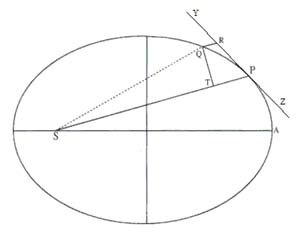
Professor Brackeridge says that Theorem 3 of De motu is Newton's crowning achievement in dynamics (p 90). It is Proposition VI, Theorem V, Corollary 1 of the Principia, as follows:
If a body P revolving about the centre S, describes a curve APQ, which a right line ZPR touches at any point P; and from any other point Q on the curve, QR is drawn parallel to the distance SP, meeting the tangent in R; and QT is drawn perpendicular to the distance SP: [then] the centripetal force will be reciprocally as the solid \( {SP^2 \times QT^2} \over QR \), if the solid be taken of' that magnitude which it ultimately acquires when the points P and Q coincide.
Theorem 3 is so highly regarded because it is the key to solving direct problems (given the orbit, find the force law). Newton follows up with a number of applications, including elliptical orbits, the one most of interest (see below). The reference to "the solid" towards the end of the the theorem is due to the units length4/length = length3. The phrase "reciprocally" means inverse variation - that the quantity varies according to the reciprocal. Note the diagram (straight from Newton) shows an ellipse, but Theorem 3 applies to any orbit. Here again the analogy with projectile motion at earth's surface is employed, where the motion along the arc from P to Q is produced by combining a tangential component along the tangent ZPRY together with a radial component along PS or equivalently its parallel segment QR. Brackenridge calls this the "parabolic approximation" and explains (p 28):
The parabolic approximation assumes that at "the very beginning of its motion" the force at any point on a given curve is approximately constant. Thus, the combination of the initial tangential velocity and the acceleration due to that constant force gives rise to a vanishingly small parabolic arc that will approximate the element of the general curve at the given point. No explicit properties of the parabola are employed, but the magnitude of the force is taken as proportional to the radial displacement and inversely proportional to the square of the time.
So Newton employs the Galilean formula for the radial displacement: QR = ½at², and using F = ma to substitute for a: QR = ½·F/m·t² ~ F/t², using ~ to denote "is proportional to". Rearranging and noting that time t is proportional to the area of sector SPQ (equal areas in equal times), which in turn approaches the area of ΔSPQ in the limit :
\[ F \sim {QR \over t^2} \sim {QR \over {(1/2 \cdot SP \cdot QT)}^2} \sim {QR \over {SP^2 \cdot QT^2}}. \]
Newton says reciprocal (inverse) variation and uses the reciprocal of the expression on the right, but it amounts to the same thing. QED.

This application has no actual physical significance, but shows how to use Theorem 3 to solve direct problems. It is easier than the actual Kepler problem, where the center of force is a focus rather than the center of the ellipse as here, but also gets the geometry of the ellipse into play, so is most suitable as a warmup exercise. Here it is, Theorem 3, Problem 2 of De motu and Proposition X, Problem V of the Principia:
If a body revolves is an ellipsis [ellipse] : it is proposed to find the law of centripetal force tending to the centre of the ellipsis.
Newton will need two theorems about ellipses from Apollonius or actually, in the second case, easily derived therefrom. These are the theorems and the links are to proofs I've provided, Apollonius himself being just about impenetrable, to me anyway:
Ap1: If PCG, DCK be conjugate diameters [of an ellipse], and QV an ordinate of PG, [then] QV² : PV · VG :: CD² : CP².
Ap2: In a given ellipse, let PG and DK be conjugate diameters, AC = ½a and BC = ½b the semi-major and semi-minor axes of the ellipse respectively, and P any point on the ellipse. Drop the perpendicular from P to DK, meeting DK at F. Then CD·PF = ¼ab = CA·CB = constant.
Conjugate diameters go back to Apollonius and were considered important late into the 19th century, disused (unfortunately) as they are today. A diameter is simply a line segment connecting opposite points on an ellipse and going through the center. A diameter conjugate to a given one is parallel to the ellipse at one of the points of tangency of the first diameter. Every chord parallel to a diameter is bisected by its conjugate. An ordinate is a line segment from a point on the ellipse to a diameter and parallel to its conjugate. Conjugate diameters of an ellipse are analogous to perpendicular diameters of a circle, and there is always an affine transformation taking one into another. Ordinates are pretty close to what they are in modern usage if we affinely map the ellipse to a circle. This leads to a number of nice theorems well known to Newton and heavily used by him in what follows (see here for details).
On to problem 2 and first the diagram, with key elements as found in the earlier diagram for Theorem 3. Now ellipse center C is in the role of the center of force. Think of the planet as moving from A to P to Q in the course of revolving in its orbit. ZPR is tangent to the orbital path at P and PCG is a diameter, in this case through the center of force C. DCK is conjugate to PCG (ie, it is parallel to ZPR). As with the general case in Theorem 3, RQ is the displacement due to the central force and RQ is parallel to PCG, while QT is perpendicular to PCG. Additionally, QV is parallel to RP and PF is perpendicular to DCK, meeting DCK at F.
The setup is as required for Ap1, so:
\[ \begin{equation}{{{PV \cdot VG} \over QV^2} = {PC^2 \over CD^2}.} \tag{0} \end{equation} \]
Since PVQR is a parallelogram, PV = QR. And \( VG \rightarrow 2 \cdot PC \) as \( Q \rightarrow P \); that is, VG = 2·PC in the limit. Making these substitutions and multiplying by QV2:
\[ \begin{equation}{{2 \cdot QR \cdot PC} = {QV^2 \cdot {PC^2 \over CD^2}}.} \tag{1} \end{equation} \]
Next note that ΔPCF ~ ΔQVT. That's because both are right triangles and ∠PCF = ∠QVT, since each is the angle between the conjugate diameters. Therefore:
\[ \begin{equation}{{QV^2 \over QT^2} = {PC^2 \over PF^2}, \text{ or} \hspace{10pt} QV^2 = {{QT^2 \cdot PC^2} \over PF^2}.} \tag{2} \end{equation} \]
Plugging the value for QV2 from (2) into (1) leads to:
\[ \begin{equation}{{2 \cdot QR \cdot PC} = {{{QT^2 \cdot PC^2} \over PF^2} \cdot {PC^2 \over CD^2}}.} \tag{3} \end{equation} \]
From Ap2, CD·PF = CA·CB = constant, so (3) can be rearranged to isolate the key quantity from Theorem 3:
\[ F \sim {QR \over {PC^2 \cdot QT^2}} = {{1 \over {2 \cdot CD^2 \cdot PF^2}} \cdot PC} = \left({1 \over {2 \cdot CA^2 \cdot CB^2}}\right) \cdot PC. \]
The parenthesized expression is constant for a given ellipse, so by Theorem 3, the force varies directly as PC, the distance of the planet from the center of force. This is what was to be found, QEI.
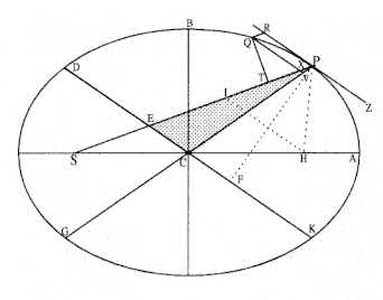
This is perhaps the most consequential result of the Principia, the solution to the "Problem of the Planets". According to David Brewster's old biography[5], as early as 1665 Newton made a decent attempt to compare gravity at the earth's surface to the gravity holding the moon in orbit, but was stymied by bad data. Getting better data in 1682, he showed that an inverse square law accounted for both:
The influence of such a result upon such a mind may be more easily conceived than described. The whole material universe was spread out before him, — the sun with all his attending planets; — the planets with all their satellites; — the comets wheeling in every direction in their eccentric orbits; — and the systems of the fixed stars stretching to the remotest limits of space. All the varied and complicated movements of the heavens, in short, must have been at once presented to his mind, as the necessary result of that law which he had established in reference to the earth and the moon.[6]
Kepler had used Tycho's extensive data to show that the orbit of Mars was an ellipse with the sun at one focus, and this proposition confirms the earth-moon calculations by proving that elliptical orbits with the center of force at one focus imply an inverse square law of attraction. Brackenridge calls it the "Kepler Problem" - see p 106 ff for his discussion of this. Newton refers to "the dignity of the problem", Theorem 3, Problem 3 of De motu and Proposition XI, Problem VI of the Principia:
If a body revolves in an ellipsis [ellipse] : it is required to find the law of centripetal force tending to the focus of the ellipsis.
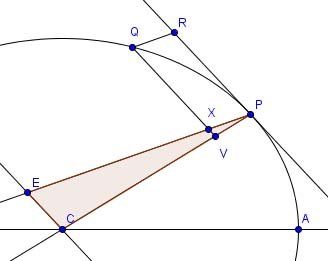
The diagram is similar to the previous one, but now foci S and H are brought in, with S being the center of force. HI is drawn parallel to DCK and ZPR, meeting SP at I. V is as before, along PCG, and X is a bit up on QV where it intersects PS (see detail here).
The first task is to find an expression for QR in order to bring Theorem 3 into play. Observe that ΔPEC ~ ΔPXV, since \( EC \parallel XV \); also that QR = PX, since they are opposite sides of a parallelogram. Therefore:
\[ {PE \over PC} = {PX \over PV} = {QR \over PV}. \]
But "it is evident" that PE = AC (Newton's words), and the proof is here for any whose insight falls short. So:
\[ \begin{equation}{QR = {PV \cdot \left({PE \over PC}\right)} = {PV \cdot \left({AC \over PC}\right)}.} \tag{4} \end{equation} \]
Now we bring in equation (0) above as in the warmup problem and eliminate PV from (0) and (4) to get:
\[ \begin{equation}{QR = {{QV^2 \over VG} \cdot {PC^2 \over CD^2} \cdot {AC \over PC}} = {{QV^2 \over VG} \cdot {PC \over CD^2} \cdot AC}.} \tag{5} \end{equation} \]
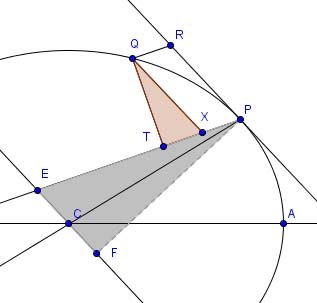
Next is to find an expression for QT². The two colored triangles in the detailed diagram here are similar. To see this, consider that the sharp angle at P is complementary to ∠EPR, whic is equal to ∠EXQ. Therefore the sharp angle at P equals the sharp angle at Q and the two right triangles are similar. Therefore:
\[ {QT \over QX} = {PF \over PE}, \hspace{15pt} \text{so} \hspace{5pt} QT^2 = QX^2 \cdot \left({PF^2 \over AC^2}\right). \]
The second equality uses PE = AC, mentioned earlier. From Ap2 above:
\[ {PF \over AC} = {BC \over DC}. \]
Substituting the last equation into the one just above it:
\[ \begin{equation}{QT^2 = QX^2 \cdot \left({BC^2 \over DC^2}\right).} \tag{6} \end{equation} \]
Plug the foregoing expressions for QR (5) and QT² (6) into Theorem 3:
\[ F \sim {QR \over {SP^2 \cdot QT^2}} = \left({{QV^2 \over VG} \cdot {PC \over CD^2} \cdot AC}\right) {\left({{1 \over QX^2} \cdot {DC^2 \over BC^2}}\right)} \cdot {1 \over SP^2} = {{QV^2 \over QX^2} \cdot {PC \over VG} \cdot {2 \over L}} \cdot {1 \over SP^2}, \]
where the second equality involves simple rearrangements and the substitution L = 2BC²/AC. L is a constant of the ellipse and in fact equal to the length of the latus rectum, a chord of the ellipse through a focus and perpendicular to the major axis. That L = 2BC²/AC is proven here. And as \( Q \rightarrow P \), so too \( QV \rightarrow QX \) and \( VG \rightarrow 2PC \). Therefore in the limit:
\[ F \sim {1 \over {L \cdot SP^2}}. \]
This shows, as Newton puts it, that "the centripetal force is reciprocally as L×SP², that is, reciprocally in the duplicate ratio of the distance SP". Or again: the force varies inversely as the square of the distance between the center of force and the orbiting planet P, the celebrated inverse square law of universal gravitation. This is what was to be found, QEI.
Abstracting from the long equation above gives an expression for the key ratio in the limit, true of ellipses with center of force at a focus, and to be used below:
\[ \begin{equation}{{QR \over QT^2} = {1 \over L}.} \tag{7} \end{equation} \]
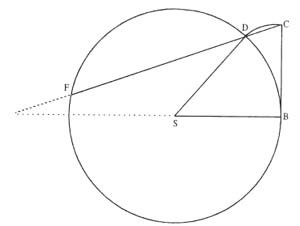
Uniform circular motion is inherently interesting, but in Theorem 2 of De motu Newton puts it to use to prove Kepler's third law assuming plants orbit in uniform circular motion:
Theorem 2: Where bodies orbit uniformly in the circumferences of circles, the centripetal forces are as the squares of arcs simultaneously described, divided by the radii of their circles.
Theorem 2 is tantamount to the well-known formula for centripetal acceleration in uniform circular motion, a = v²/r, considering that the velocity v is proportional to arc length in a given time (Newton's first corollary to Theorem 2). In the diagram, S is the center of the circle and also the center or force and B is the planet's initial location. BC is the planet's tangential path were there no centripetal force and BD its actual path under the centripetal influence. The force of attraction F is proportional to CD, the deflection in motion caused by the force. Obviously \( \overset{\frown} {BD} = \overline{BC} \) and the little circular arc DC is meant to emphasize this fact, being centered at B. Euclid III, 36 says that CD/BC = BC/CF or CD = BC²/CF. But as \( C \rightarrow B \), so too \( BC \rightarrow BD \) and \( CF \rightarrow 2r \), where r is the radius of the circle. Therefore in the limit:
\[ F \sim CD \sim {BD^2 \over 2r} \sim {BD^2 \over r}. \]
This is what was to be proved, QED.
Five corollaries follow from Theorem 2, the first that F ~ v²/r. If T is the period of one revolution, P = 2πr the perimeter, and v the velocity, then:
\[ v = {d \over t} = {{2 \pi r} \over T}. \]
\[ \therefore F \sim {v^2 \over r} = {{({2 \pi r} / T)}^2 \over r} = {{4 \pi^2 r^2} \over {T^2 r}} = {{4 \pi^2 r} \over T^2} \sim {r \over T^2}. \]
Or, as Newton says, the centripetal force varies reciprocally as the square of the periodic time divided by the radius (ie., directly as the radius divided by the square of the period) - that's corollary 2. Unlike my presentation, Newton compares two circles in framing and proving Theorem 2. He's setting up for the corollaries, including corollary 5:
Corollary 5: If the squares of the periodic times are as the cubes of the radii, then the centripetal forces are reciprocally as the squares of the radii, and conversely.
Corollary 5 shows that Kepler's third law involving 3/2 powers is equivalent to the inverse square law for uniform circular motion with the center of force at the center of the circle. To prove it, assume two planets orbiting in uniform circular motion around different circles. Then by corollary 2:
\[ \begin{equation}{{F_1 \over F_2} = {{r_1 / T_1^2} \over {r_2 / T_2^2}}.} \tag{8} \end{equation} \]
Suppose the "centripetal forces are reciprocally as the squares of the radii"; ie., the forces vary inversely as the square of the radii:
\[ \begin{equation}{{F_1 \over F_2} = {r_2^2 \over r_1^2}.} \tag{9} \end{equation} \]
Equating the two expressions for F1/F2 in (8) and (9):
\[ {r_2^2 \over r_1^2} = {{r_1 \cdot T_2^2} \over {r_2 \cdot T_1^2}}, \]
which becomes, after rearrangement:
\[ {T_2^2 \over r_2^3} = {T_1^2 \over r_1^3}. \]
This proves corollary 5 in one direction and all the steps are reversible.
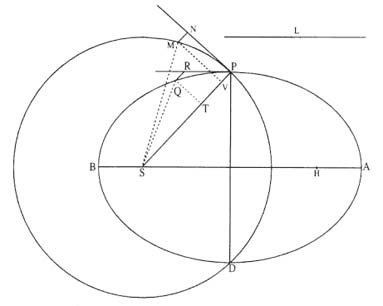
The section above shows that an inverse square law implies Kepler's third law, the 3/2 power law, for uniform circular motion. Newton uses the result for circles to prove it for ellipses, Theorem 4 of De motu (it is handled differently in the Principia):
Theorem 4: Supposing that the centripetal force is reciprocally proportional to the square of the distance from the center, the squares of the periodic times in ellipses are as the cubes of their transverse axes.
In the diagram, AB is the transverse axis of the elliptical orbit, PD the other axis of the ellipse, and S a focus. Draw a circle centered at S with radius SP, and consider the circle as an orbit for uniform circular motion with the same force emanating from S and effective at P. PR and PN are the tangential motions respectively were no force acting, QR and MN the deviations due to the force both parallel to PS. Note also that QR = MN in the limit, because each reflects the force from S acting at P. Also that 2SP = AB by the focal property of ellipses.
We want to apply (7) to both ellipse and circle. So let L be the latus rectum of the ellipse and considering that the latus rectum of a circle is the diameter:
\[ {{L \cdot QR} = QT^2} \hspace{10pt} \text{and} \hspace{10pt} {{2SP \cdot MN = MV^2}}. \]
\[ \therefore {QT^2 \over MV^2} = {{L \cdot QR} \over {2SP \cdot MN}} = {L \over 2SP}, \]
where (see above):
\[ L = {PD^2 \over AB} = {PD^2 \over 2SP}. \]
Therefore:
\[ {QT^2 \over MV^2} = {{PD^2 / 2SP} \over 2SP} = {PD^2 \over 4SP^2}, \hspace{10pt} \text{so} \hspace{10pt} {QT \over MV} = {PD \over 2SP}. \]
But also:
\[ {QT \over MV} = {{\text{Area}(\bigtriangleup SPQ)} \over {\text{Area}(\bigtriangleup SPM)}}, \]
because the triangles have bases QT and MV on the same base SP.
Finally:
\[ \text{Area(ellipse)} = {\pi a b} = {\pi \cdot SP \cdot {PD / 2}}, \hspace{10pt} \text{and} \hspace{10pt} \text{Area(circle)} = {\pi r^2} = {\pi SP^2}. \]
\[ \therefore {\text{Area(ellipse)} \over \text{Area(circle)}} = {PD \over 2SP}. \]
That is, the areas of the triangles have the same ratio as the area of the ellipse to the area of the circle. The areas of the triangles approach the areas of the sectors SPQ and SPM in the limit. The diagram represents the motion at (1/N)th of the complete circular orbit, swept out in a given increment of time. Multiply by N to get the entire circular orbit. Here is the key point - because the ratio of the sectors "generated at individual moments" (singulis momentis genitae) in Newton's words, approaches the ratio of the circle and ellipse, multiplying by N shows that the ellipse will be traversed in exactly the same time that the circle is. That is, the periods are the same. But by construction, the transverse axis of the ellipse is the same as the diameter of the circle, so the 3/2 power rule obtaining for the circle as shown above also applies to the ellipse. This is Kepler's third law, where now the rs are half the transverse axes:
\[ {T_2^2 \over r_2^3} = {T_1^2 \over r_1^3}, \]
which is what was to be proved, QED.
Mike Bertrand
August 19, 2014
^ 1. The Mathematical Principles of Natural Philosophy, by Sir Isaac Newton (originally published 1687, English translation by Andrew Motte, 1729).
^ 2. Magnificent Principia: Exploring Isaac Newton's Masterpiece, by Colin Pask, Prometheus Books (2013), ISBN 978-1-61614-745-7 ( de Moivre quote p. 75).
^ 3. De motu corporum in gyrum, by Isaac Newton. This is the nineteen page Latin document as originally written by Newton, here titled Propositiones De Motu. It appears to agree verbatim with the copy in Whiteside and is an appendix to Historical Essay on the First Publication of Sir Isaac Newton's Principia, by Stephen Peter Rigaud, Oxford University Press (1838).
^ 4. The Key to Newton's Dynamics: The Kepler Problem and the Principia, by J. Bruce Brackenridge, University of California Press (1995), ISBN 0-520-20217-1.
^ 5. The Mathematical Papers of Isaac Newton, Volume VI (1684-1691), by D. T. Whiteside (ed.), Cambridge University Press, Cambridge, Great Britain (1974).
^ 6. The Life of Sir Isaac Newton, by David Brewster, Harper & Brothers, Publishers, New York (1831). Newton made a decent attempt: p 141-2; The influence of such a result: p 144.